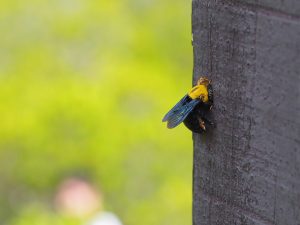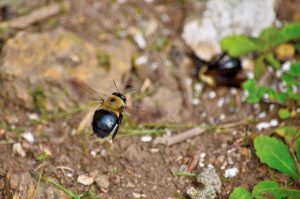CARPENTER BEES – THEY’RE BACK AND BUSY!
By Chris Williams on April 26, 2018.
We’re starting to see some straggler carpenter bees emerging from last season’s galleries with thoughts of making some galleries of their own.
Carpenter bees are big and the male bee can be loud and even aggressive (but he can’t sting). These bees are shiny black with a fuzzy, yellow thorax and look similar to bumble bees but carpenter bees are not part of a large colony. They work only in pairs, although more than one pair may occupy a desirable location.
THESE BIG BEES DEVELOP INSIDE WOOD

Carpenter Bee making hole. Shutterstock.
Carpenter bees are unique because they excavate their nest sites in softened wood, chewing out a tubular gallery and provisioning each newly laid egg with a ball of pollen for the hatching larva to feed on. Typical carpenter bee nest sites are in soft, weathered, unpainted woods in sites like decks and deck furniture, soffits, eaves, fascia boards, wooden siding, even mailbox posts.
The female does all the work burrowing into the wood and collecting the pollen. We usually first notice the buzzing male bee who guards the nest site under construction and pretend-attacks anything that comes close. Unlike him, the female carpenter bee can sting but she’s not aggressive.
WOODPECKERS CAUSE FOLLOWUP DAMAGE
Once the female has provisioned about 6-8 cells in her gallery nest, she leaves her offspring to fend for themselves and the pair moves on. The whole process lasts for just days. After all is quiet in late May, you may notice the circular opening to the nest although these dime-sized holes are usually on the unpainted backside or underside of a piece of wood. By summer, woodpeckers may point the nest sites out to you since they like to peck into the galleries to feed on the fat bee larvae inside (see The Woodpecker-Carpenter Bee Connection). Woodpeckers are usually the real cause of damage blamed on carpenter bees.
Larvae that survive the woodpeckers and other predators turn into adult bees in late summer, chew their way out of the gallery, and visit plants as beneficial pollinators. When the weather gets colder in fall, these adult bees often return to their old nest site to spend the winter.
DAMAGE BECOMES NOTICEABLE WITH REPEAT NESTING

Carpenter Bee. Shutterstock.
Carpenter bees are often finished excavating the nest by the time the homeowner notices the activity. While carpenter bee damage is mostly cosmetic, rarely causing any structural damage, it can be more serious if multiple pairs of bees are nesting in the same site and if they are using the site again the following spring. In cases where carpenter bee nesting is an issue, the wood needing protection can be treated with an insecticide to deter the bees and kill those emerging. Painting, staining, or sealing unfinished woods can also discourage the bees that prefer to chew into naked wood. Replacing susceptible wood trim with synthetic materials is another possibility.
If carpenter bees are a problem, give Colonial Pest a call. For more on carpenter bees, take a look at these earlier Colonial blogs.
• Is It a Carpenter Bee or Bumble Bee?
• Carpenter Bees Are Nest Building…Again!
• Carpenter Bee Visits Are Brief and Stings Are Rare